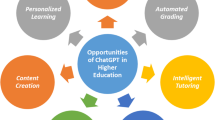Abstract
To check students’ daily language learning tasks and give students corresponding reasonable scores based on their daily behavior is hard for teachers. The existing online language learning systems are vulnerable and easy to be modified by teachers or system managers. Blockchain can provide immutable and trusted storage service and automatic calculation service. Therefore, a blockchain-based online language learning system is proposed in this paper to monitor students’ daily study and automatically evaluate their behavior so as to save teachers from tedious and complex homework verification workload and provide trusted and reliable evaluation on students’ behavior. This paper first introduces the current situation of language learning in universities and the related works on blockchain-based online language learning system. Then the system is detailed in its structure and smart contracts. At last, we implement this system and do the analysis and summary.







Similar content being viewed by others
References
Kugamoorthy, S, & Sunil Weerakoon, W. M.: Continuous assessment methods: Critical review for quality improvement of the post graduate diploma in education programme of the open university of Sri Lanka.
Ma, J. (2019). Hong Kong college students’ perceptions of continuous assessment in the context of academic literacy instruction. In English literacy instruction for Chinese speakers (pp. 265–280). Springer.
Alayafi, E. G., & Gunduz, P. (2017). An essential tool for continuous assessment: The learning portfolio. In Revisiting EFL assessment (pp. 237–259). Springer.
Trotter, E. (2006). Student perceptions of continuous summative assessment. Assessment and Evaluation in Higher Education, 31(5), 505–521.
Nakamoto, S., et al. (2008). Bitcoin: A peer-to-peer electronic cash system.
Mingxiao D, Xiaofeng M, Zhe Z, Xiangwei W, & Qijun C. (2017). A review on consensus algorithm of blockchain. In 2017 IEEE international conference on systems, man, and cybernetics (SMC) (pp. 2567–2572). IEEE.
Fernández-Caramés, T. M., & Fraga-Lamas, P. (2019). Towards next generation teaching, learning, and context-aware applications for higher education: A review on blockchain, iot, fog and edge computing enabled smart campuses and universities. Applied Sciences, 9(21), 4479.
Han, M., Li, Z. He, J., Wu, D., Xie, Y., & Baba, A. (2018). A novel blockchain-based education records verification solution. In Proceedings of the 19th annual SIG conference on information technology education (pp. 178–183).
Liu, Q., Guan, Q., Yang, X., Zhu, H., Green, G., & Yin, S. (2018). Education-industry cooperative system based on blockchain. In 2018 1st IEEE international conference on hot information-centric networking (HotICN) (pp. 207–211). IEEE.
Gräther, W., Kolvenbach, S., Ruland, R., Schütte, J., Torres, C., & Wendland, F. (2018). Blockchain for education: Lifelong learning passport. In Proceedings of 1st ERCIM Blockchain workshop 2018. European Society for Socially Embedded Technologies (EUSSET).
Al Harthy, K., Al Shuhaimi, F., & Al Ismaily, K. K. J. (2019). The upcoming blockchain adoption in higher-education: Requirements and process. In 2019 4th MEC international conference on big data and smart city (ICBDSC) (pp. 1–5). IEEE.
Hori, M., Ono, S., Miyashita, K., Kobayashi, S., Miyahara, H., Kita, T., et al. (2018). Learning system based on decentralized learning model using blockchain and sns. CSEDU, 1, 183–190.
Wu, B., & Li, Y. (2018). Design of evaluation system for digital education operational skill competition based on blockchain. In 2018 IEEE 15th international conference on e-business engineering (ICEBE) (pp. 102–109). IEEE.
Lizcano, D., Lara, J. A., White, B., & Aljawarneh, S. (2019). Blockchain-based approach to create a model of trust in open and ubiquitous higher education. Journal of Computing in Higher Education, 32, 1–26.
Zhong, J., Xie, H., Zou, D., & Chui, D. K. W (2018). A blockchain model for word-learning systems. In 2018 5th international conference on behavioral, economic, and socio-cultural computing (BESC) (pp. 130–131). IEEE.
Grech, A., & Camilleri, A. F (2017). Blockchain in education.
Karale, A., & Khanuja, K. Blockchain technology in education system: A review. International Journal of Computer Applications, 975, 8887.
Williams, P. (2019). Does competency-based education with blockchain signal a new mission for universities? Journal of Higher Education Policy and Management, 41(1), 104–117.
Chen, G., Bing, X., Manli, L., & Chen, N.-S. (2018). Exploring blockchain technology and its potential applications for education. Smart Learning Environments, 5(1), 1.
Rooksby, J., & Dimitrov, K. (2019). Trustless education? A blockchain system for university grades 1. Ubiquity: The Journal of Pervasive Media, 6(1), 83–88.
Wood, G., et al. (2014). Ethereum: A secure decentralised generalised transaction ledger. Ethereum Project Yellow Paper, 151(2014), 1–32.
Ocheja, P., Flanagan, B., & Ogata, H. (2018). Connecting decentralized learning records: A blockchain based learning analytics platform. In Proceedings of the 8th international conference on learning analytics and knowledge (pp. 265–269).
Donet, J. A. D., Pérez-Sola, C., & Herrera-Joancomartí, J. (2014). The bitcoin p2p network. In International conference on financial cryptography and data security (pp. 87–102). Springer.
Chris, D. (2017). Introducing ethereum and solidity (Vol. 1). Berlin: Springer.
Androulaki, E., Barger, A., Bortnikov, V., Cachin, C., Christidis, K., De Caro, A., Enyeart, D., Ferris, C., Laventman, G., Manevich, Y., et al. (2018). Hyperledger fabric: A distributed operating system for permissioned blockchains. In Proceedings of the thirteenth EuroSys conference (pp. 1–15).
Donovan, A. A. A., & Kernighan, B. W. (2015). The Go programming language. Boston: Addison-Wesley Professional.
Acknowledgements
The work was supported by the National Key Research and Development Program of China (No. 2018YFC1315404) and scientific research key grand “Genre analysis of English academic research papers on the basis of Internet resources” of Wuhan College (KYZ 201906).
Author information
Authors and Affiliations
Corresponding author
Ethics declarations
conflict of interest
The authors declare that they have no conflict of interest.
Additional information
Publisher's Note
Springer Nature remains neutral with regard to jurisdictional claims in published maps and institutional affiliations.
Rights and permissions
About this article
Cite this article
Sun, X., Zou, J., Li, L. et al. A blockchain-based online language learning system. Telecommun Syst 76, 155–166 (2021). https://doi.org/10.1007/s11235-020-00699-1
Published:
Issue Date:
DOI: https://doi.org/10.1007/s11235-020-00699-1




